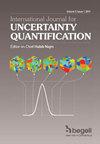索博尔敏感度指数--利用给定数据动态自适应方差估计器的机器学习方法
IF 1.8
4区 工程技术
Q2 ENGINEERING, MULTIDISCIPLINARY
International Journal for Uncertainty Quantification
Pub Date : 2024-09-01
DOI:10.1615/int.j.uncertaintyquantification.2024051654
引用次数: 0
摘要
如今,全局敏感性分析已成为一门广受认可的学科,在越来越多的领域得到广泛应用。在全局灵敏度方法中,基于方差的技术和基于蒙特卡罗的与索博尔灵敏度指数相关的估算器因其通用性和易于解释而被广泛采用。通过使用准蒙特卡罗序列、对输入组的研究以及通过性能更高的估计器(如作者最近提出的基于动态自适应方差的创新算法)计算灵敏度指数,可以减少所需的模型评估。本文提出了一种机器学习方法,使我们能够使用出色的动态自适应方差估计器,从一组蒙特卡罗给定数据开始估计索博尔指数。我们对三个相关函数进行了测试。在大多数情况下,测试结果都非常令人满意,而且似乎克服了设计数据方法的限制,保留了索博尔蒙特卡洛估计器的所有优点。本文章由计算机程序翻译,如有差异,请以英文原文为准。
Sobol’ sensitivity indices– A Machine Learning approach using the Dynamic Adaptive Variances Estimator with Given Data
Global sensitivity analysis is today a widely recognized discipline with an extensive application in an increasing number of domains. Today, methodological development and available software, as well as a broader knowledge and debate on the topic, make investigations feasible which were simply impossible or too demanding a few years ago.
Among global sensitivity methods, the variance-based techniques and Monte Carlo-based estimators related to Sobol’ sensitivity indices are mostly implemented due to their versatility and easiness of interpretation. Nevertheless, the strict dependency of the analysis cost on the number of the investigated factors and the need of a designed input are still a major issue.
A reduction of the required model evaluations can be achieved with the use of quasi-Monte Carlo sequences, the study of groups of inputs, and the sensitivity indices computation through higher performing estimators such as the Innovative Algorithm based on dynamic adaptive variances recently proposed by the authors. However, all these strategies even cutting significantly the necessary model runs are not able to overcome the barrier of a structured input.
This paper proposes a machine learning approach that allows us to estimate Sobol’ indices using the outstanding dynamic adaptive variances estimator starting from a set of Monte Carlo given data. Tests have been run on three relevant functions. In most cases, the results are very promising and seem to positively overcome the limit of a design-data approach keeping all the advantages of the Sobol’ Monte Carlo estimator.
求助全文
通过发布文献求助,成功后即可免费获取论文全文。
去求助
来源期刊

International Journal for Uncertainty Quantification
ENGINEERING, MULTIDISCIPLINARY-MATHEMATICS, INTERDISCIPLINARY APPLICATIONS
CiteScore
3.60
自引率
5.90%
发文量
28
期刊介绍:
The International Journal for Uncertainty Quantification disseminates information of permanent interest in the areas of analysis, modeling, design and control of complex systems in the presence of uncertainty. The journal seeks to emphasize methods that cross stochastic analysis, statistical modeling and scientific computing. Systems of interest are governed by differential equations possibly with multiscale features. Topics of particular interest include representation of uncertainty, propagation of uncertainty across scales, resolving the curse of dimensionality, long-time integration for stochastic PDEs, data-driven approaches for constructing stochastic models, validation, verification and uncertainty quantification for predictive computational science, and visualization of uncertainty in high-dimensional spaces. Bayesian computation and machine learning techniques are also of interest for example in the context of stochastic multiscale systems, for model selection/classification, and decision making. Reports addressing the dynamic coupling of modern experiments and modeling approaches towards predictive science are particularly encouraged. Applications of uncertainty quantification in all areas of physical and biological sciences are appropriate.
 求助内容:
求助内容: 应助结果提醒方式:
应助结果提醒方式:


